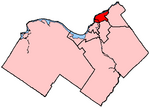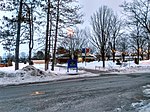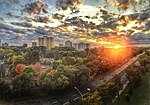Notre-Dame Cemetery (Ottawa)
Burials at Notre-Dame Cemetery (Ottawa)Cemeteries in OttawaCommonwealth War Graves Commission cemeteries in CanadaPages with missing ISBNsRoman Catholic cemeteries in Canada ... and 1 more
Tourist attractions in Ottawa

Notre Dame Cemetery, is a Catholic cemetery in Ottawa, Ontario, Canada. Opened in 1872, it is the most prominent Catholic cemetery in Ottawa. The cemetery's western edge is located in Vanier, just south of Beechwood Cemetery. Its eastern limit is St. Laurent Boulevard. The cemetery is the final resting place for more than 114,000 people.
Excerpt from the Wikipedia article Notre-Dame Cemetery (Ottawa) (License: CC BY-SA 3.0, Authors, Images).Notre-Dame Cemetery (Ottawa)
Montfort Street, Ottawa Vanier (Rideau-Vanier)
Geographical coordinates (GPS) Address Nearby Places Show on map
Geographical coordinates (GPS)
| Latitude | Longitude |
|---|---|
| N 45.442 ° | E -75.652 ° |
Address
Montfort Street 409
K1L 6B3 Ottawa, Vanier (Rideau-Vanier, Les Jardins des Montfort)
Ontario, Canada
Open on Google Maps








